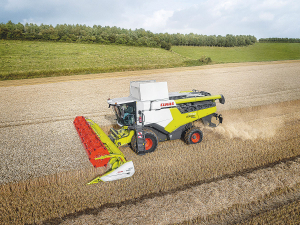Claas has announced several improvements for all 2023-delivery Lexion 8000/7000 harvesters.
These include increased engine power, greater grain tank volume, a new cab and improved operator assistance systems.
The Lexion 8800 now features a 16.2 litre, MAN D42 six-cylinder engine producing a maximum output of 700 hp. Meanwhile, the 8700, 7700 and 7600 models stick with the 12.5 litre, six-cylinder Perkins 2206 D engine, delivering 571, 524 or 461 hp, respectively.
All engines are equipped with Dynamic Cooling and Dynamic Power. The former is an on-demand, variable drive cooling system that reduces power requirement by 26hp, featuring a horizontal cooling system that creates a ‘curtain’ that prevents dust from rising.
Dynamic Power is an engine management system that automatically adjusts power output to field conditions for maximum fuel efficiency, with savings of up to 10%.
Released in 2019, the LEXION 8000/7000 features the enlarged APS Synflow Hybrid threshing system that delivers 10% more capacity than the previous 700 series. All Hybrid machines delivered to Australia are fitted with the segmented feed drum to further optimise the flow of material from the threshing unit to the Roto Plus rotors under extreme operating conditions.
8000 Terra Trac models can be fitted with 18,000 or 15,000 litre grain tanks, while 7000 TT models have the option 13,500 or 12,500 litre bins.
The 420mm and 330mm diameter unloading augers can be fitted with a pivoting spout to allow precise control of the grain stream by up to 60cm, with operation via the CMotion multifunction control lever.
Machines for 2023 delivery will have a larger cab, featuring larger front and side windows, thinner A-pillars and a cantilevered mirror design to deliver a premium view of the header.
On top of this, a 360- degree wiper ensures a wide field of vision ahead, with other creature comforts including a 30l cooler, swivelling leather seat, footrests and 360- degree LED lighting.
Upgrades to the operating and machine optimisation systems sees a new 12-inch CEBIS terminal with a higher resolution, higher contrast display and has three adjustable main display areas. A second 12-inch CEMIS 1200 terminal can be positioned on the righthand side of the cab if the GPS Pilot automated steering system is fitted.
Functions within the CEMOS machine optimisation system, include a new dialogbased system that guides the operator through the calibration process to minimise grain loss.
CEMOS Dialog and CEMOS Automatic are operated by touch and the rotary/push controls. Meanwhile, all threshing and cleaning settings can be accessed quickly using direct access buttons on the right-hand side of the operating armrest.
On the header front, Claas has introduced a new machine optimisation system that automatically adjusts the table length and reel position of its Vario variable cutter-bars. The new system uses sensors in the feed channel and on the cabin roof to measure the position of the table length and the vertical and horizontal position of the reel. It is from here that the Cemos function automatically adjusts the settings for optimal performance.
This is said to promote even crop flow and reduce the load on all components from the cutter-bar to the feeder housing and the primary and secondary separation systems. This results in improved throughput, efficiency and grain quality.
Claas has also introduced the new canola knives and reel drive found on the Vario 1380, 1230 and 1080 models to its smaller models. This improves the cutting force by 50% - thanks to the mechanical drives and integrated overload clutch. The new reel drive uses a hydraulic driveline instead of a chain drive, which makes it possible to utilise the full adjustment range of the table and pushes service intervals out to 500 hours.
The new models also feature a pressuredependent reel height adjustment that automatically matches the reel speed to ground speed. If large crop volumes cause the reel speed to decrease, the reel is automatically raised until the required reel speed is recovered, then the reel automatically lowers to the pre-determined height.
For larger operators, Claas has a released a new 50-foot version of its popular Convio Flex draper front, meaning working widths are available at 15.3, 13.8, 12.3 and 10.8 metres. All models incorporate flexible knife bars, tables and side belts that enable them to have flex/ movement up to 90mm upwards and 135mm downwards.
This is claimed to be ideal for harvesting crops that are close to the ground, such as pulses or lodged crops. These machines have several practical automatic functions that optimise performance and reduce operator stress, control belt speed, reel traction and height for optimum crop flow and minimal grain loss in all crops and harvesting conditions.
“In grain mode, the cutter-bar is set rigid and cutting height is controlled using the sensing bands underneath the unit,” Claas says. “In Flex mode, the cutterbar follows the ground contours on skids with contact pressure controlled via the Active Float function."
The company recommends Auto Flex mode when harvesting crops close to the ground on uneven surfaces, with the cutter-bar using sensor data to continuously determine the best position for optimum crop flow and ground tracking – as well as the lowest cutting height.


















